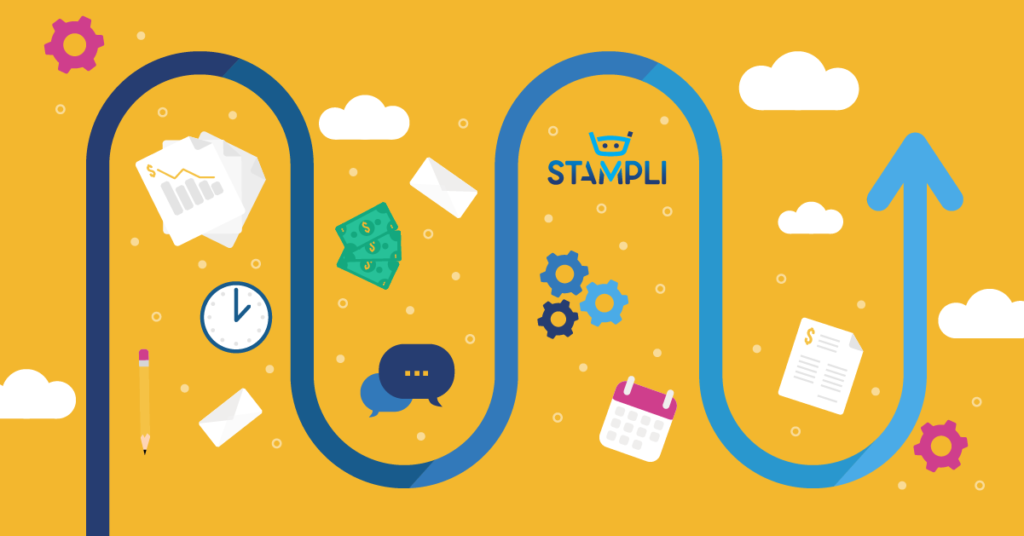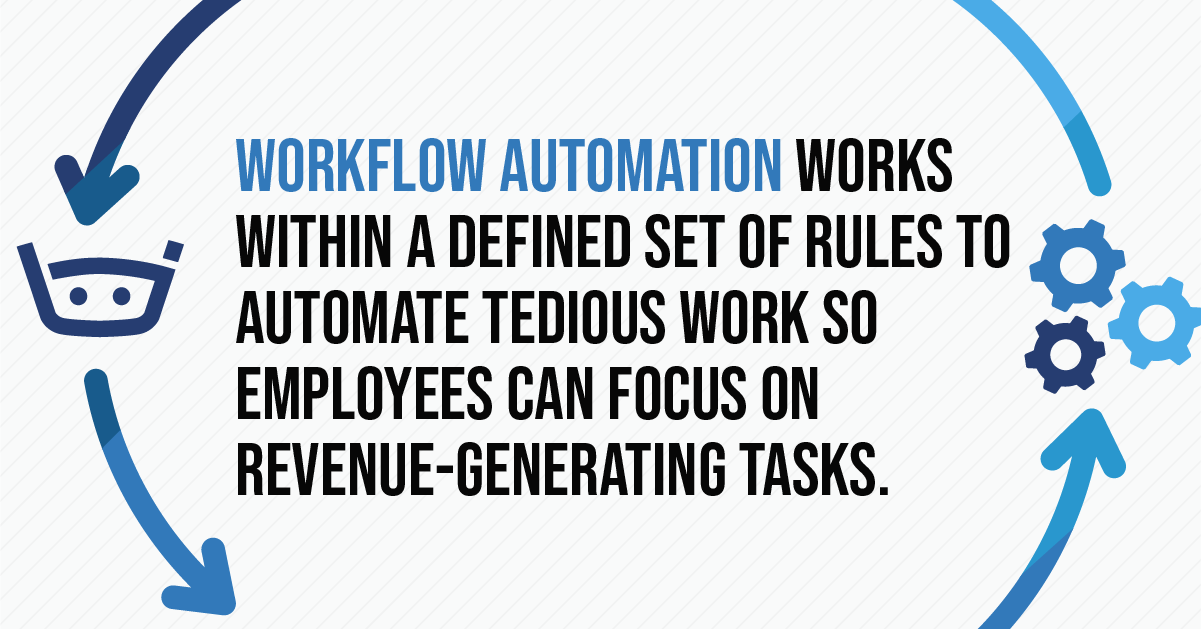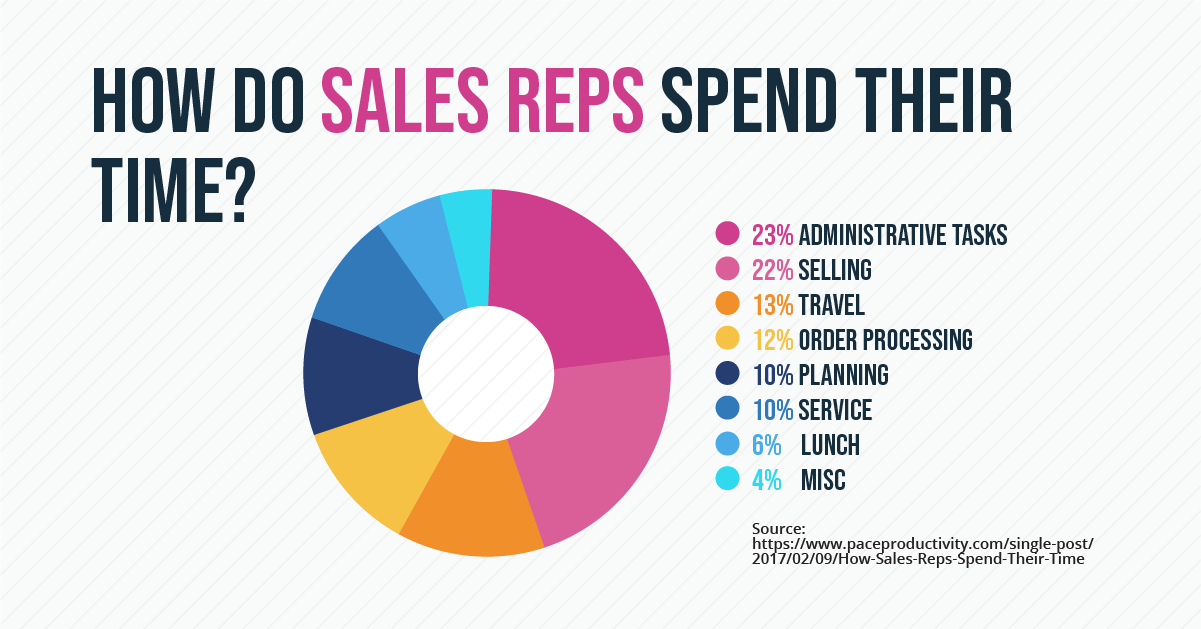Workflow Automation for Mid-Market Firms

How could your business improve if you had more time? What would happen if you spent less time manually processing invoices, tracking down meeting invites, or managing file sharing? What could your sales team do if they had more time to spend reaching out to customers?
Would your business make more sales? Would you work on your businesses’ long term strategy? Provide better customer service? Or just have a better work-life balance?
If you and your team are stretched thin and find yourselves pushing off critical tasks, you might be wondering if there is a better way.
There is— workflow automation might be the solution you are looking for.
What is Workflow Automation?
Workflow automation is the process of uncovering opportunities and designing solutions to automate often repetitive manual actions in a business process. For example, workflow automation can automate file transfers, resource scheduling, setting up new accounts, and even invoice processing capturing.
Workflow automation works within a defined set of rules. Essentially, you are telling software, “If this happens, do this.” Workflow automation rules can be simple or complex. You might tell the software, “If A happens, do a. If B happens, do b. If A and B happen, do C,” and so forth.

What happens when a salesperson gets a new lead? They spend time creating a new account, adding contact information, updating preferences, and adding any info they’ve gathered. What if that process was automated?
Your salespeople could reduce the amount of time they spend on administrative tasks and focus on responding to making calls, which is where 92% of all sales interactions happen.
But, the benefits of workflow automation go beyond sales. Here is how it can help your business.
The Benefits of Workflow Automation
- Streamlines communication: Workflow automation centralizes conversations in one place. This saves time and helps keep everyone organized. No more sorting through your inbox to find that vendor quote or those meeting minutes from two weeks ago.
- Creates accountability: Workflow automation systems make it easier to track processes and see who did what and when they completed each step. This makes it easier to see, for example, that John is running late on delivering a brief or that Susan approved an invoice.
- Reduces costs and error: Automating workflow processes significantly reduces errors and ensures that your records are as accurate as possible. Most data is entered just once or is gathered directly from emails, which reduces transcription errors. Plus, fixing errors takes just one update, versus making adjustments in several documents.
- Improves efficiency: Workflow automation streamlines processes, making it easier to get more done in less time. Tasks that require approval can be automatically assigned to the correct person in seconds, eliminating back and forth emails and reminders.
- Fewer repetitive tasks: Eliminating repetitive tasks gives employees more time to focus on critical tasks and can improve employee morale as they have more time to do work they care about. Boring tasks such as document generation, creating accounts, or loading invoices can be automated entirely.
- Gain access to real-time analytics: Each step in the workflow process is tracked and reported in real-time, giving management access to data for both immediate and long-term strategic planning. Information can be automatically transferred into a CRM or other business systems.
Common Business Processes Your Business Can Automate Today
Workflow automation is on the rise. By 2020, we can expect to see more than 1 million jobs replaced by automation, according to an article by Forbes. Firms that fail to implement workflow automation may find it difficult to compete with more efficient businesses that can do more in less time and with fewer employees.
Here are five processes that can be fully or partially automated using workflow automation tools.
Marketing
Marketing is an area that is ripe for automation. Businesses can automate email marketing, social media posts, and even engagement on social media sites like Instagram. Trigger emails, which are automatically sent when a lead completes a specific task, such as abandoning their cart, can help your business stay in touch with little effort.
Other marketing automation opportunities include email list segmentation, automatic bids for PPC, and auto-sharing new blogs as they are published.
Human Resources
At its core, human resources is about people, which makes the process difficult to automate. While some level of human interaction will always be necessary, several HR processes can be automated, including benefits management, the application process, PTO tracking, and compliance.
Finance
Your business may be able to automate several finance department processes, including travel requests, reimbursements, budget approvals, and other tedious tasks. Keep in mind; automation doesn’t mean automatically approving all reimbursement requests. Instead, your business can set specific rules.
For example, you might automatically approve all requests under $25, then send requests over that amount to the proper admin for approval.
Accounts Payable
If you are still using a paper AP process, it is time to change. AP workflow automation tools can autoload information from invoices, connect invoices with purchase orders, manage documents, and streamline your unique approval processes. Plus, with the help of machine learning, automation software can help you identify potential instances of fraud and even prevent double payments. With accounts payable workflow automation, this means no more late payments, and far less paperwork.
Sales
The average sales rep spends just 22% of their time selling. The rest of the time is eaten up with administrative tasks, order processing, and planning. Each year, companies lose $1 trillion dollars in sales and wasted marketing spend due to poorly managed leads.

Workflow automation can streamline administrative tasks and planning so your salespeople can focus on what they do best—selling. Sales automation tools can create automatic reports, standardize processes, even automatically follow up with leads.
Best Workflow Automation Software Tools
Workflow automation can streamline a variety of processes, from HR to sales. But, which tools are right for your company? Here are some favorites.
Stampli for AP Automation
If your business is still using paper invoices and manual AP processes, it is time to change it up. Stampli is an AP automation tool driven by machine learning. This means as you do more, it learns more. Features include automatic invoice management capture, enhanced fraud detection, centralized collaboration tools, and an easy setup process designed to work with your approval workflow and accounting system.
Pipedrive for Sales
Pipedrive helps eliminate sales team busywork by taking over repetitive admin tasks in the sales processes. Features include tracking emails and contacts, managing leads, qualifying leads, booking meetings, calendar management, and even creating fully customizable web forms.
BambooHR for Human Resources
BambooHR starts by gathering and organizing information and data during the onboarding and hiring process. It can also assist with employee onboarding, streamline benefits tracking, help measure employee engagement, develop reports, and much more. It aims to help HR professionals work more efficiently, not totally automate the process.
Zapier for Everything Else
Zapier is a flexible automation tool that allows businesses to connect a wide range of web apps—especially apps that do not natively work together. Using Zapier, you can automate file delivery, email marketing, time tracking, and even eCommerce tasks. It supports Slack, Google Drive, Dropbox, Zoom, GoToMeeting, and many others.
Honorable Mention: If This Then That: Originally designed for consumers, IFTTT helps connect and automate a ton of processes for businesses and people. For example, it can automate blog sharing, share Instagram photos as native photos on Twitter, and help your phone’s voice assistant do more. Or, you can turn your outside lights on for the pizza guy, if that’s your thing.
The Right Time for Workflow Automation Is Now
Time is money, as the old saying goes. If your team is spending a significant amount of time on tedious tasks, if accountability is becoming a hassle, or if communication is getting muddled, workflow automation may be the key to freeing up resources and working more efficiently.
Businesses that wait to implement workflow automation will struggle to compete in the coming years. Ready to get started? Here’s how Stampli can help automate your business’ AP process.